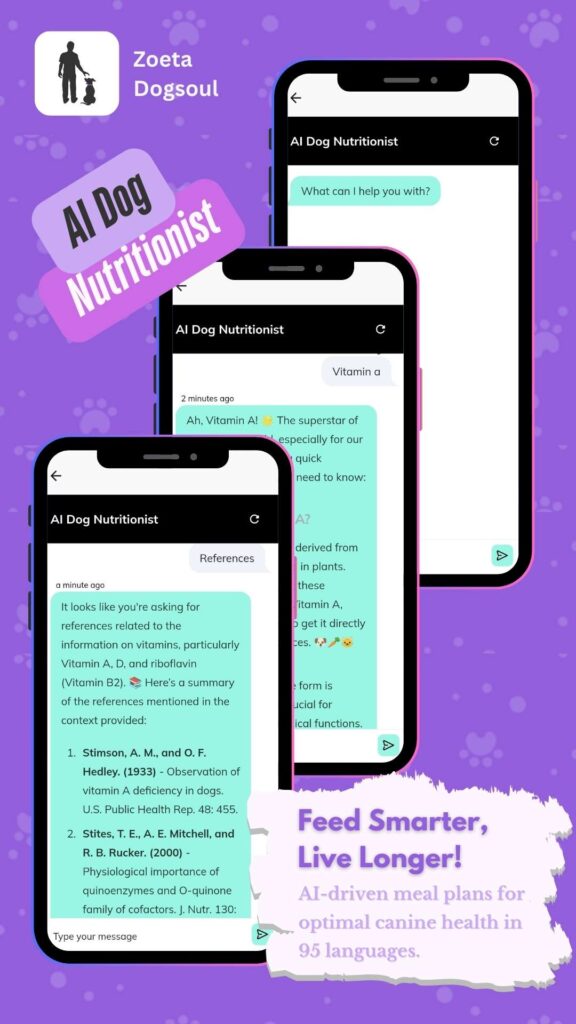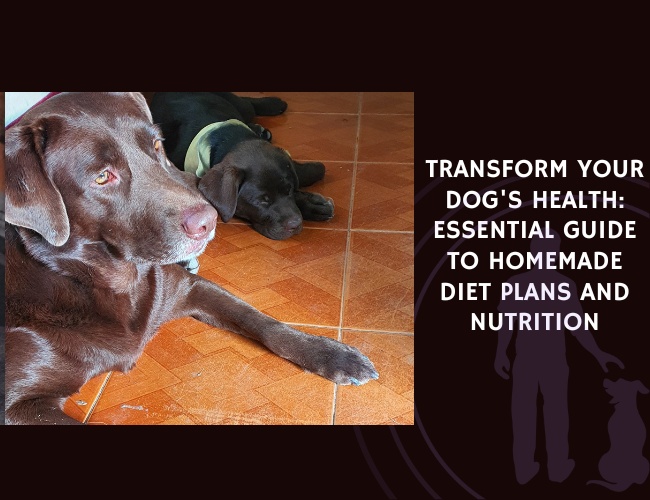The Hidden Dangers of Commercial Kibble
When it comes to feeding our dogs, convenience can often overshadow nutritional quality. Commercial kibble, while easy to store and serve, has hidden dangers that can significantly impact your dog’s health. Let’s dive into these concerns.
Nutritional Degradation Through High-Temperature Processing
One of the primary issues with commercial kibble is the high-temperature processing used to manufacture it. The process involves cooking the ingredients at extremely high temperatures to ensure a long shelf life. However, this method has a downside: it destroys essential enzymes and amino acids, leading to the degradation of vital nutrients. Dogs are left with food that is significantly less nutritious than its whole food counterpart.
Although manufacturers attempt to compensate by adding artificial vitamins and minerals, these additions are not as bioavailable—meaning they are not as easily absorbed and utilized by your dog’s body..
Risks Associated With Artificial Preservatives, Colors, and Harmful Additives
To make kibble look appealing and last longer on shelves, manufacturers often add artificial preservatives, colors, and flavors. Preservatives like BHA, BHT, and ethoxyquin have been linked to various health problems, including cancer and organ damage. Additionally, artificial colors and flavors can trigger food intolerances or allergies, making your pet uncomfortable or ill.
Connection Between Processed Pet Food and Chronic Health Conditions
There’s growing evidence that links long-term kibble consumption to chronic health issues in dogs. These issues include allergies, obesity, kidney disease, and digestive problems. Many commercial kibbles contain poor-quality ingredients, such as meat by-products and fillers like high levels of starch and grains. These ingredients contribute to obesity and diabetes and are often misrepresented on ingredient labels, making it difficult to understand what you’re truly feeding your pet.
Furthermore, dry pet food is susceptible to mycotoxins (toxins produced by mold) and bacterial contamination, introducing additional health risks. The combination of inadequate nutritional content and potential contaminants means kibble could be doing more harm than good over the long term.
Conclusion
Understanding the hidden dangers of commercial kibble is crucial for any responsible pet owner. Awareness of these issues is the first step towards making healthier dietary choices for your dog.
Transitioning to a diet that prioritizes whole food ingredients can profoundly benefit your dog’s health. In our next discussion, we will explore how to switch to fresh, homemade dog food, highlighting its numerous advantages.
Benefits of Switching to Fresh, Homemade Dog Food
Switching your dog to a fresh, homemade diet can make a world of difference. This chapter will dive into why whole food ingredients offer better nutrient absorption, improve overall health markers such as coat quality and joint health, and allow for meal customization based on your dog’s specific needs.
Enhanced Nutrient Absorption and Digestibility
One of the most significant advantages of fresh, homemade dog food is the heightened absorption and digestibility of nutrients. Unlike commercial kibble, which often relies on high-temperature processing that degrades essential nutrients, fresh food retains its natural vitamins, enzymes, and amino acids. This preservation means your dog assimilates these nutrients more effectively, leading to improved digestion and overall health.
Whole food ingredients, such as fresh meats, vegetables, and healthy fats, provide a bioavailability that processed foods struggle to match. They facilitate better nutrient absorption, ensuring that your dog gets the balanced nutrition they need without unnecessary fillers or harmful additives.
Improved Overall Health Markers
When you feed your dog a diet rich in whole food ingredients, you’ll likely notice improvements in several health markers. For instance, omega-3s and natural vitamins found in fresh foods contribute significantly to coat quality. Dogs on homemade diets often have shinier, healthier coats compared to those on processed kibble diets.
Joint health also benefits from the inclusion of natural supplements and whole food ingredients. Homemade diets can be tailored to include joint-supportive elements like glucosamine and chondroitin found in bone broth or green-lipped mussel powder. These components are vital for maintaining mobile and pain-free joints, especially in aging dogs prone to arthritis.
Customizable Meals for Specific Needs
Another compelling reason to switch to a homemade diet is the ability to customize meals based on your dog’s specific breed requirements and health conditions. Each dog is unique, and their diet should reflect that individuality.
- Breed-Specific Needs: Smaller breeds like Chihuahuas or Yorkshire Terriers have higher metabolisms and require more frequent, nutrient-dense meals. Medium breeds like Border Collies need balanced protein and fat ratios, while large breeds such as German Shepherds benefit from controlled portions to manage weight and joint stress.
- Special Health Conditions: Dogs with specific health issues can also benefit from a tailored diet. Brachycephalic breeds, for example, may need anti-inflammatory diets to aid in respiratory function. Herding breeds require higher proteins and omega-3s for mental sharpness, while allergy-prone dogs benefit from novel proteins like duck or venison.
The ability to tweak and adjust recipes ensures that your dog’s nutritional needs are met efficiently, promoting long-term health and vitality.
Making the switch to fresh, homemade food isn’t just about providing a tastier meal; it’s about investing in your dog’s long-term health and happiness. Tailoring a diet that aligns with their unique needs can lead to a fuller, more active life.
While transitioning to a homemade diet offers numerous benefits, it’s essential to ensure nutritional balance and monitor your dog’s health markers. As we move forward, we’ll explore how to tailor nutrition based on your dog’s size and specific dietary requirements.
Tailoring Nutrition to Your Dog’s Size
Every dog is unique, but one of the most significant factors influencing their nutritional needs is their size. Understanding the specific dietary requirements of small, medium, and large breeds ensures that your dog receives balanced, tailored nutrition.
Small Breed Considerations
Higher Metabolism and Frequent, Nutrient-Dense Meals
Small breed dogs, like Chihuahuas and Yorkshire Terriers, have higher metabolisms compared to their larger counterparts. This means they burn energy quickly and require frequent, nutrient-dense meals to maintain optimal health and prevent hypoglycemia. Because these tiny canines can’t eat large portions in one sitting, it’s crucial to focus on providing meals packed with essential nutrients.
Diet Plan for Small Breeds:
- Protein: 45-50% from sources like turkey, rabbit, or fish.
- Healthy Fats: 15-20% from coconut oil or fish oil.
- Carbohydrates: 10% from pumpkin or carrots.
- Calcium: Additions like ground eggshell or crushed sardines provide necessary calcium.
This high-protein, high-fat diet, supplemented with healthy carbs and calcium, supports the accelerated metabolic rate and energy needs of small dogs and helps maintain their overall health and vitality.
Medium Breed Requirements
Balanced Protein and Fat Ratios for Sustained Energy
Dogs in the medium breed category, including Beagles and Border Collies, strike a balance between energy needs and portion sizes. These dogs require a moderate amount of protein and fat to sustain muscle mass and energy levels without leading to obesity or other health issues.
Diet Plan for Medium Breeds:
- Protein: 40-45% from beef or chicken.
- Healthy Fats: 10-15% sourced from omega-3-rich foods like fish oil.
- Fiber & Antioxidants: 15% from vegetables such as sweet potatoes and spinach.
This diet provides balanced nutrition tailored to maintain the muscular and energetic needs of medium breeds while also supplying vital fiber and antioxidants to promote overall health benefits.
Large Breed Needs
Controlled Portions and Joint-Supporting Nutrients
Large breeds, like German Shepherds and Great Danes, have specific dietary needs focused on supporting their massive frames and reducing the risks of obesity and joint-related issues. These dogs often have a lower metabolism per pound and need carefully controlled portions.
Diet Plan for Large Breeds:
- Protein: 40% from lean meats like venison or beef.
- Healthy Fats: 15% from salmon oil.
- Calcium and Glucosamine: Sources such as green-lipped mussel powder to support joint health.
Large breeds benefit significantly from a diet that supports their joints and controlled calorie intake to prevent excessive weight gain and its associated health problems.
By tailoring your dog’s diet to their size-specific requirements, you ensure they receive optimal nutrition to support their health, energy, and quality of life. This individualized approach can help prevent potential health issues and promote a happier, healthier life for your furry friend.
Understanding the importance of balanced and size-specific nutrition is just the beginning. In the next series of chapters, we will delve further into creating balanced homemade meals tailored to each dog’s unique needs. This journey toward optimal pet health continues with a focus on the essential components that make up these meals.
Creating Balanced Homemade Meals
Switching to homemade meals for your dog is a significant step toward improving their overall health. This chapter will guide you through creating balanced and nutritious homemade meals, ensuring that all essential components are included and tailored to meet specific needs.
Essential Components: Protein Sources, Healthy Fats, and Vegetables Ratios
A well-rounded diet for your dog should be balanced, incorporating a variety of protein sources, healthy fats, and vegetables. Here’s a breakdown of the essential components:
- Protein Sources (40-50%):
Protein is vital for muscle development and overall health. Consider lean meats like:- Beef
- Turkey
- Lamb
- Healthy Fats (10-15%):
Fats are crucial for energy and coat health. Healthy fat sources include:- Fish oil
- Coconut oil
- Salmon oil
- Vegetables (15-20%):
Vegetables provide essential vitamins, minerals, and fiber. Ideal options are:- Pumpkin
- Zucchini
- Carrots
- Sweet potatoes
- Spinach
These components work together to offer a well-rounded meal that supports your dog’s energy levels, muscle growth, and overall vitality.
Proper Supplementation with Calcium and Essential Nutrients
Proper supplementation ensures that your homemade meals remain nutritionally complete. Here are the key supplements:
- Calcium Source (5%):
Calcium is crucial for bone health and development. Suitable sources include:- Ground eggshells
- Bone meal
- Crushed sardines
- Essential Supplements (5%):
Additional supplements help to meet all nutritional needs:- Probiotics
- Turmeric
- Green-lipped mussel powder (for joint support)
These supplements play an essential role in providing the necessary nutrients that may not be sufficiently present in whole foods alone.
Special Dietary Considerations for Breeds with Specific Health Concerns
Different breeds have unique dietary needs, especially if they have specific health concerns. Here are some to consider:
- Brachycephalic Breeds:
Dogs with short muzzles (like Pugs and Bulldogs) benefit from anti-inflammatory diets to prevent respiratory issues. Include:- Omega-3 fatty acids
- Turmeric
- Herding Breeds:
These breeds (such as Border Collies) require higher protein and omega-3s for mental sharpness:- Salmon
- Flaxseed oil
- Giant Breeds:
Large breeds (like Great Danes) need to avoid excess calcium during puppyhood to prevent joint disorders:- Lean meat sources
- Joint-supporting supplements like glucosamine
- Allergy-Prone Breeds:
Some dogs are susceptible to food allergies and do best on novel proteins:- Duck
- Venison
By catering to these specific needs, you can create a diet that not only meets the basic nutritional requirements but also supports overall health and addresses any breed-specific concerns your dog may have.
Transitioning to a homemade diet may seem overwhelming initially, but with the right knowledge and preparation, it becomes a manageable and rewarding endeavor. Your dog will thank you with improved health and vitality, reflecting the care and thought you put into their diet.
Transitioning Your Dog to a Fresh Diet
Switching your dog’s diet from commercial kibble to fresh, homemade meals can be a transformative journey for your dog’s health. However, making this shift requires careful planning and patience to ensure it’s done safely and effectively. Here’s a detailed guide to help you navigate this transition.
Step-by-Step Guide for a Gradual 10-14 Day Transition Period
Transitioning your dog to a fresh diet should be a gradual process, typically taking between 10 to 14 days. This slow transition helps to prevent digestive upset and allows your dog to acclimate to the new food.
- Days 1-3: Mix 25% Fresh Food with 75% Kibble
Start by mixing 25% fresh food with 75% of your dog’s regular kibble. This allows their digestive system to start adjusting to the new diet. - Days 4-6: Increase to 50% Fresh Food and 50% Kibble
If your dog is handling the change well, increase the amount of fresh food to 50%, while reducing the kibble to 50%. - Days 7-9: Mix 75% Fresh Food with 25% Kibble
By this time, your dog’s digestive system should be accommodating the fresh food more easily. Now, you can mix 75% fresh food with only 25% kibble. - Days 10-14: Switch to 100% Fresh Food
If no digestive issues have arisen, you can complete the transition to 100% fresh food.
Monitoring Health Indicators During the Switch
Monitoring your dog’s health is crucial during this transition period. Keep a close eye on the following indicators to ensure they are adjusting well:
- Stool Quality: Check for changes in consistency and frequency. Ideally, stool should remain firm and regular, indicating that your dog is digesting the new food properly.
- Energy Levels: Note any fluctuations in your dog’s energy levels. They should remain stable or improve as they adjust to a more nutrient-dense diet.
- Coat Condition: Pay attention to the condition of your dog’s coat. A fresh diet rich in omega-3 fatty acids should enhance coat quality, making it shinier and less prone to dryness.
- Appetite and Water Consumption: Monitor your dog’s appetite and water consumption. A healthy appetite and normal water intake are good signs that they are adapting well.
Troubleshooting Common Transition Challenges
Even with a gradual transition, some dogs may face challenges when switching to a fresh diet. Here are some common issues and how to address them:
- Digestive Upset: If you notice diarrhea or vomiting, slow down the transition process. Go back to the previous step and give your dog more time to adjust before moving forward.
- Picky Eating: Some dogs may be reluctant to try new foods. Mixing the fresh food with a bit of low-sodium broth or gently warming it can make it more appealing.
- Allergies or Sensitivities: If your dog shows signs of an allergic reaction such as itching, swelling, or excessive licking, consult your veterinarian. They may need to identify and eliminate the problematic ingredient.
- Weight Changes: Monitor your dog’s weight closely. If they start to gain or lose too much weight, adjust portion sizes accordingly and consult with a veterinary nutritionist to rebalance the diet.
Transitioning your dog to a fresh diet is a commitment that requires diligence and patience. However, the benefits of a healthier, more vibrant life for your furry friend are well worth the effort. Remember, while the journey can be challenging, it can also be deeply rewarding.
Continuing to monitor and adjust your dog’s diet as needed will ensure long-term success and optimal health.
Maintaining Long-term Success
Embarking on a fresh, homemade diet for your dog can significantly change their health and well-being. However, the journey doesn’t stop at the initial transition. Ensuring long-term success requires ongoing effort and attention to detail. This chapter will be your guide to maintaining your dog’s health through periodic assessments, working with professionals, and incorporating beneficial supplements.
Regular Monitoring of Weight, Energy Levels, and Coat Health
One of the most critical aspects of sustaining a nutritious, homemade diet for your dog is regular monitoring. By keeping a close eye on weight, energy levels, and coat health, you’ll be able to make timely adjustments to their diet and overall care routine. Here’s how to effectively monitor each aspect:
- Weight: Regularly weigh your dog to ensure they maintain an ideal weight. Monitoring weight helps identify any issues related to overfeeding or underfeeding. If your dog’s weight changes significantly, it might indicate that dietary adjustments are necessary.
- Energy Levels: Notice your dog’s energy throughout the day. Reduced energy could be a sign of nutritional deficiencies or health issues, whereas heightened energy generally signifies a well-balanced diet.
- Coat Health: A shiny, smooth coat usually indicates good health. Monitor for any changes such as dryness, shedding, or dullness, as these can be symptoms of nutritional imbalance or health problems.
Regular vet visits enable further monitoring and professional insight into your dog’s overall health.
Working with Veterinary Professionals for Dietary Adjustments
It’s crucial to work with veterinary professionals to fine-tune your dog’s diet. Veterinary nutritionists can help ensure that your homemade diet meets all the necessary nutritional requirements. Here’s how collaborating with professionals can assist in maintaining long-term success:
- Regular Check-ups: Schedule routine veterinary visits for comprehensive health assessments. These visits allow vets to catch any early signs of health issues and recommend necessary dietary adjustments.
- Nutritional Advice: Veterinary nutritionists can provide specific guidance on meal composition, portion sizes, and the inclusion of essential nutrients, ensuring that your dog’s diet remains balanced and effective.
- Addressing Specific Health Concerns: For dogs with special health conditions or breed-specific dietary needs, a professional can tailor the diet to meet those demands, preventing long-term health issues.
Incorporating Beneficial Supplements Like Bone Broth and Fish Oil
In addition to whole foods, incorporating supplements like bone broth and fish oil can significantly enhance your dog’s diet:
- Bone Broth: Rich in essential nutrients, bone broth supports joint health, gut health, and overall immunity. Serving a small amount of bone broth daily or weekly can provide these benefits.
- Fish Oil: High in omega-3 fatty acids, fish oil promotes a shiny coat, reduces inflammation, and supports brain and joint health. Adding the recommended dosage of fish oil to your dog’s meals ensures they receive these crucial nutrients.
Continually evaluating which supplements benefits your dog the most can make a significant difference in their overall health.

By consistently monitoring your dog’s health, actively collaborating with veterinary professionals, and incorporating beneficial supplements, you can ensure the long-term success of your dog’s homemade diet. With these measures in place, your dog is well on their way to a healthier, happier life.
Now that you’ve gone the extra mile to understand the potential downsides of commercial kibble, why not take the next step to ensure your dog’s well-being? Transforming your dog’s diet doesn’t have to be daunting. Embrace the challenge by exploring homemade diet plans tailored to meet your furry friend’s unique nutritional needs.
Delving into the world of homemade meals allows you to:
- Control Ingredient Quality: Choose fresh, whole foods that provide the nutrients your dog needs.
- Eliminate Harmful Additives: Avoid preservatives, artificial colors, and flavors that could harm your pet.
- Promote Better Health: Nourish your dog’s body with a diet that supports a healthy weight, boosts energy, and enhances overall wellness.
Ready to make the switch? Start by exploring our comprehensive guide on homemade dog diets. Discover delicious, nutritious recipes, and learn how to create a balanced meal plan for your canine companion. Your dog’s health is worth the effort, and you’ll feel even more connected to your pet by nourishing them with love and care.
Take the first step towards a healthier, happier canine today—start your journey into homemade dog nutrition now!










